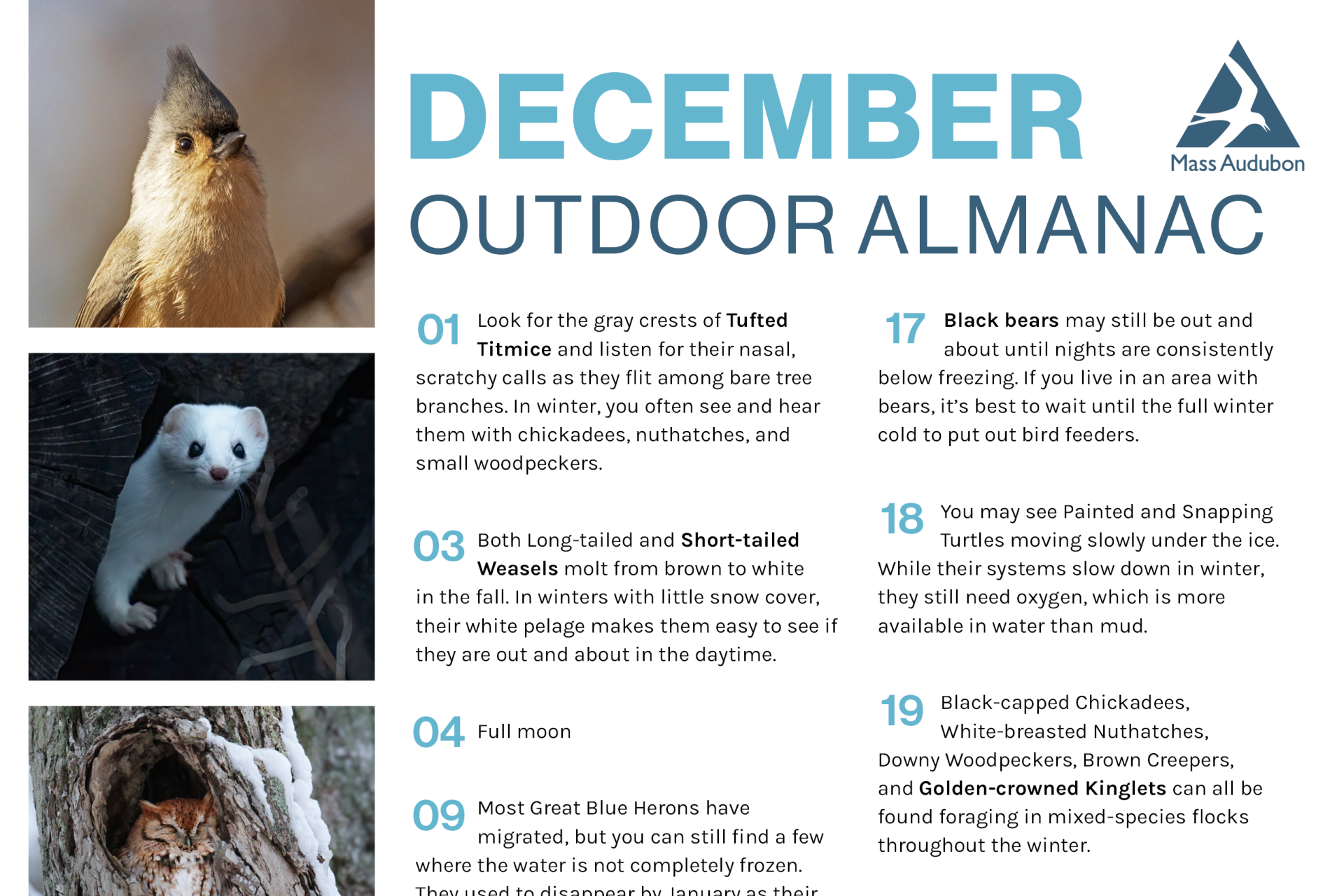Outdoor Almanac
Winter settles in with December’s long nights and crisp days, but the natural world is anything but still. Birds flock together, weasels shift into winter camouflage, and owls sun themselves in tree cavities. Even under the ice, turtles and other creatures carry on their quiet routines. Explore the many small marvels waiting just beyond your doorstep.
What will you discover this December? Visit a nearby wildlife sanctuary or join us for a program to make the most of your month.

Outdoor Almanac
Download or print this month's Outdoor Almanac.
DECEMBER
1
Look for the gray crests of Tufted Titmice and listen for their nasal, scratchy calls as they flit among bare tree branches. In winter, you often see and hear them with chickadees, nuthatches, and small woodpeckers.
3
Both Long-tailed and Short-tailed Weasels molt from brown to white in the fall. In winters with little snow cover, their white pelage makes them easy to see if they are out and about in the daytime.
4
Full Moon
9
Most Great Blue Herons have migrated, but you can still find a few where the water is not completely frozen. They used to disappear by January as their access to fish froze over, but with warmer winters, a few of them remain year-round.
10
On cold nights at the beginning of winter, damp or wet areas of the ground can form ice needles.
11
Eastern Screech-Owls roost in tree cavities, perching in the sunlight to soak up the warmth with their eyes open just enough to monitor their surroundings.
13-14
It’s the peak of the Geminid meteor shower, with as many as 120 shooting stars per hour visible in the dark sky from midnight to dawn.
17
Black bears may still be out and about until nights are consistently below freezing. If you live in an area with bears, it’s best to wait until the full winter cold to put out bird feeders.
18
You may see Painted and Snapping Turtles moving slowly under the ice. While their systems slow down in winter, they still need oxygen which is more available in water than mud.
19
Black-capped Chickadees, White-breasted Nuthatches, Downy Woodpeckers, Brown Creepers, and Golden-crowned Kinglets can all be found foraging in mixed-species flocks throughout the winter.
21
Today is the winter solstice. It’s the shortest day and longest night of the year, and the official start of winter. Even though daylight increases from now until June, our coldest weather is still to come.
25
Look for shiny, leathery, evergreen Christmas ferns in the snowy woods.
28
Keep an eye out for Giant Silk Moth cocoons on your winter walks. Cecropia caterpillars spin a gray-brown, spindle-shaped cocoon along the length of a small branch, while Polyphemus cocoons are rounder, less securely attached, and often covered with a leaf.
Upcoming Programs this Month
See MoreDecember School Vacation Days
-
Wachusett Meadow Wildlife Sanctuary, Princeton
-
3 classes starting
Monday, December 29
9:00am-3:00pm
Age 7 - 12
December School Vacation Days
-
Wachusett Meadow Wildlife Sanctuary, Princeton
-
Monday, December 29
9:00am-3:00pm
Age 7 - 12
December School Vacation Days
-
Wachusett Meadow Wildlife Sanctuary, Princeton
-
Tuesday, December 30
9:00am-3:00pm
Age 7 - 12
December School Vacation Days
-
Wachusett Meadow Wildlife Sanctuary, Princeton
-
Wednesday, December 31
9:00am-3:00pm
Age 7 - 12
Wednesday Morning Birding
-
Newburyport and vicinity
-
Wednesday, December 31
9:30am-12:30pm
Adults
New Year's Day Birdwatching
-
Ipswich River Wildlife Sanctuary, Topsfield
-
Thursday, January 1
8:00-11:00am
Adults
Stay Connected
Don't miss a beat on all the ways you can get outdoors, celebrate nature, and get involved.



